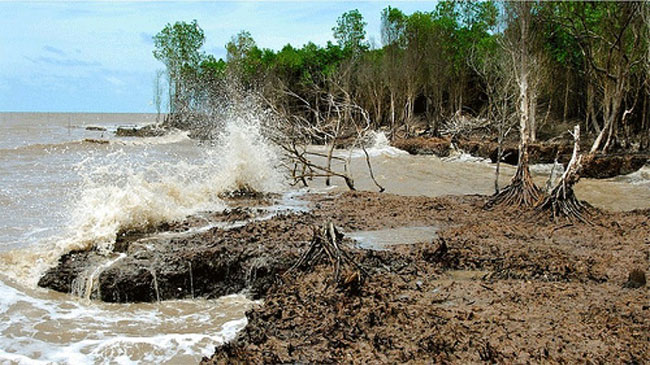The whole Mekong Delta is subsiding at a rate of nearly 2.5cm per year
In the West Sea region (Ca Mau peninsula) previously had a high encroachment rate to the sea, now 70% of the area has retreated.
On December 18, WWF announced the results of the project to strengthen the capacity of social organizations in participating in water resource governance in the Mekong Delta region by this agency and the Vietnam Rivers Network. (VNR) and the People's Aid Coordination Committee (PACCOM) have been implemented over the past two years.
The research team stated that the upstream area is being impacted by hydroelectric dams, causing sediment and sediment into the Mekong Delta to completely change the hydrological regime of the downstream. This impact reduces the adaptability of the whole region.
WWF's studies from 2013 to 2015, analyzing more than 2,000 satellite images show that in the East Sea (Ben Tre and Tra Vinh provinces), up to 48% of the coast area shows regressive, in when only 22% showed signs of encroaching on the sea.

Ca Mau peninsula area has the strongest rate of subsidence and coastal encroachment.(Photo: VNA).
In the West Sea region (Ca Mau peninsula) where previously there was a high encroachment rate, now 70% of the area has retreated.
"The whole of the Mekong River Delta is being subsided gradually at a rate of 0.5 - 2.5 cm / year, the areas with the fastest and most subsidence are Ho Chi Minh City, Ca Mau, Bac Lieu and Soc Trang. , Tra Vinh " , the report stated.
In addition, water pollution due to intensive farming, fisheries and industrial zone development and riverside urban areas is also alarming. The use of about 2 million tons of chemical fertilizers, nearly 500,000 tons of pesticides annually can cause risks of environmental incidents due to residual toxic chemicals in the water environment.
Many different models of aquatic farming with large scale result in the amount of waste discharged into the Tien and Hau rivers, making the level of harm to the water environment worse, causing bad impacts on water quality. and epidemics arise.
The amount of waste water of 12,700 operating enterprises has not been thoroughly treated, continue to be discharged into receiving sources of rivers, canals and rivers, reducing surface water quality, causing epidemics for aquaculture and especially harmful to people's health.
The research team gave 5 recommendations. One of them is to maintain the operation of the water resource management network in the Mekong Delta with key members in the provinces through the focal point of MekongNet in Can Tho and the river network in Hanoi. .
Expand members who are individuals, local community groups, social organizations, non-governmental organizations to enhance information sharing, replication of successful initiatives and models in governance raw water, livelihood development.
- Environmental protection of surface water in the Mekong Delta
- The Mekong Delta risks being submerged under the sea
- 30 years for a sustainable agriculture
- H1N1 flu broke out in the Mekong Delta
- The Mekong Delta provinces are penetrated by saltwater 70km deep
- Subsidence in the delta is related to human activity
- Do not dig more channels in the forest
- Brag about the
- Bird flu recurrence in the Mekong Delta: The epidemic is expanding!
- Protection of mangrove ecosystem in Mekong Delta
- AusAID grants clean water to poor people in the Mekong Delta
- Vietnam is supported to adapt to climate change
 Is the magnetic North Pole shift dangerous to humanity?
Is the magnetic North Pole shift dangerous to humanity? Washington legalizes the recycling of human bodies into fertilizer
Washington legalizes the recycling of human bodies into fertilizer Lightning stone - the mysterious guest
Lightning stone - the mysterious guest Stunned by the mysterious sunset, strange appearance
Stunned by the mysterious sunset, strange appearance